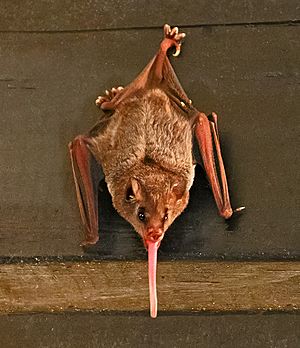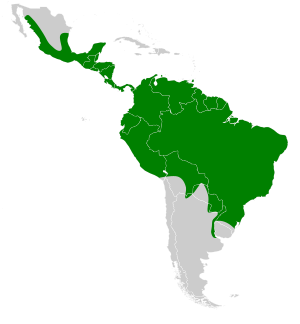Pallas's long-tongued bat facts for kids
Quick facts for kids Pallas's long-tongued bat |
|
|---|---|
 |
|
| Conservation status | |
| Scientific classification | |
| Genus: |
Glossophaga
|
| Species: |
soricina
|
 |
|
The Pallas's long-tongued bat (Glossophaga soricina) is a fascinating bat found in South America and Central America. These bats have a very fast metabolism and mostly eat nectar from flowers.
Amazing Metabolism of the Pallas's Bat
This bat has one of the fastest metabolisms ever seen in a mammal. Its body uses energy almost as quickly as a hummingbird's! Even though it uses up half of its stored fat each day, most of its energy comes straight from the simple sugars in the nectar it eats. This means it doesn't store much of that energy.
These bats don't just eat nectar. They also enjoy pollen, parts of flowers, fruit, and even small insects.
How the Bat's Tongue Works
A special study in 2013 found something amazing about the Pallas's long-tongued bat's tongue. It can "mop up" nectar using its blood! This is a very unique way to feed in nature.
When the bat sticks out its tongue, tiny hairs at the tip stand up. These hairs are usually flat. They fill with blood, making them stiff and straight, like tiny brushes. This makes the tongue tip grow longer by more than half its normal size!
The tongue also gets narrower. This squeezes special blood vessels along the tongue, pushing blood towards the tip and into those tiny hairs. This clever system helps the bat collect nectar very efficiently. It's believed this amazing feeding method helps these bats survive even when food is scarce.
See also
 In Spanish: Murciélago siricotero de Pallas para niños
In Spanish: Murciélago siricotero de Pallas para niños


